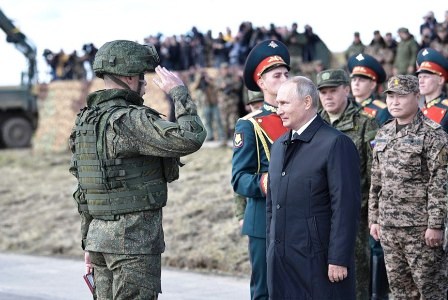Russia’s growing military relations with regional countries and its large-scale drills suggest that Russia’s geopolitical presence is increasing in the region and it could well become a potent regional power soon.
[Yead Mirza]
Soviet Union had good military and economic relations with the Asia Pacific’s regional countries. The demise of the Soviet Union had significantly hampered the relations between Russian Federation, which is deemed to be the successor to Soviet Union, and Asia Pacific’s countries.
However, Russia’s growing sale of weapons and other advanced military technology to a number of Asia-Pacific countries for the last one decade reflects Moscow’s desperation to re-establish the lost military relations with the Asia Pacific countries.
Russia had successfully managed to keep close military relations with China and India, both of which have been engaged in a rivalry since late-1950s.
Moreover, Russia is increasingly building good relations with many South Asian and Southeast Asian countries, including Bangladesh, Indonesia, Malaysia, Myanmar, Pakistan, the Philippines and Thailand.
Furthermore, Russia is on a spree of building certain infrastructures in several Asia Pacific countries which would make those countries dependent on Russia for the proper functionality of those infrastructures. Take for example the nuclear plant in Bangladesh, a small country located in the intersection of South Asia and Southeast Asia. Russia is setting up a nuclear-powered power plant in Bangladesh, and this infrastructure would certainly make Bangladesh dependent on Russia for the technological aspects of the project. Bangladesh has also been purchasing heavy weapons and military vehicles from Russia.
Late last year, many regional countries were surprised by Russia’s large scale war games. The fact that the war games was conducted in the eastern part of Russia – which forms part of the Asia Pacific region, unlike Russia’s western part that forms part of Europe – raised many eyebrows in Western capitals who thought they now have a new competitor in Asia Pacific region.
The war games, namely Vostok-2018 or East-2018, involved more than 300,000 troops, 36,000 tanks, 1000 aircraft, helicopters and drones and 80 warships and support vessels.
More surprising was the inclusion of the Chinese military into the war games alongside the Russians. Around 3500 Chinese troops were said to have taken part in the Russian war games. Troops from Mongolia too joined the drills.
- New York Times Critiqued Indian Media for Spreading Falsehoods
- Syria and Pakistan: Current Geopolitical and Social Parallels
Sergei Shoigu, Russian Defense Minister, boasted about the drills saying, “Imagine 36,000 military vehicles moving at the same time: tanks, armored personnel carriers, infantry fighting vehicles – and all of this, of course, in conditions as close to a combat situation as possible.”
It seems that although Russia’s military clout in Europe and Middle East are well understood and acknowledged, Russia’s growing engagement in the Asia Pacific region is largely underestimated and underrated.
Accordingly, the growing influence of Russia in the region finds less attention on the regional media outlets, the regional discussion platforms and the think-tank papers produced across the region. This is a total contrast to Russian involvement in Europe and Middle East, something which receives huge coverage.
Despite the low coverage of Russian activities in the greater Asia Pacific, Russia’s growing military relations with regional countries and its large-scale drills suggest that Russia’s geopolitical presence is increasing in the region and it could well become a potent regional power soon.
Yead Mirza is a blogger, writer and observer of global current affairs.

